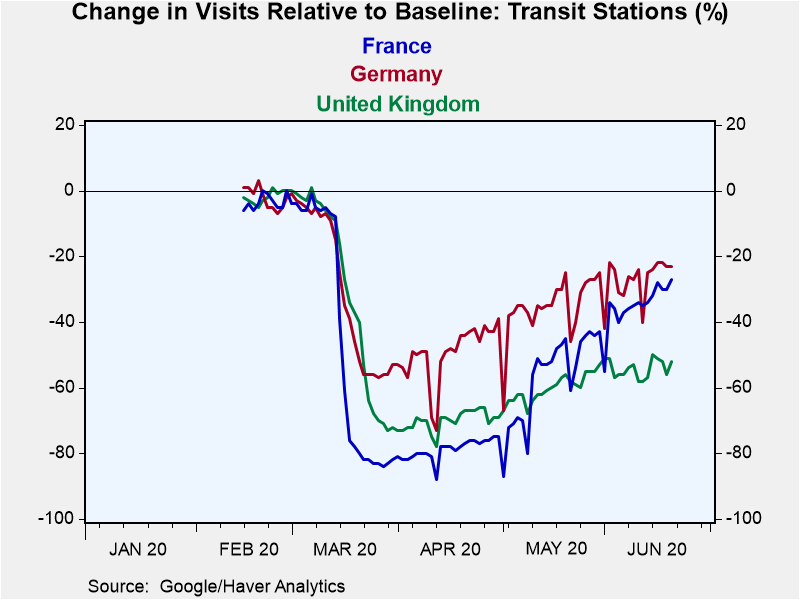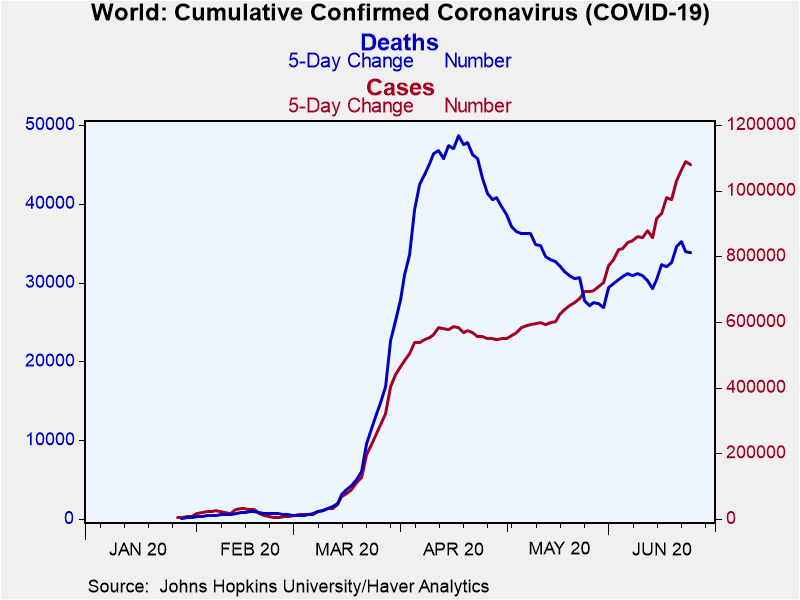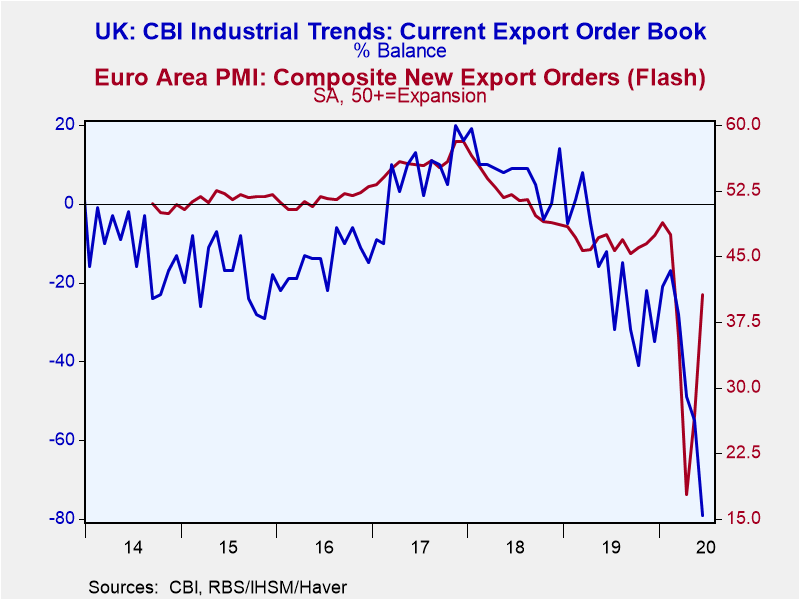 Global| Jun 25 2020
Global| Jun 25 2020Some Relief for Europe But Not Much
by:Andrew Cates
|in:Viewpoints
Summary
European financial markets welcomed the news earlier this week that June's flash purchasing managers indices for the Eurozone and the UK had recovered much of the ground that they lost in April and May. The headline composite index [...]
European financial markets welcomed the news earlier this week that June's flash purchasing managers indices for the Eurozone and the UK had recovered much of the ground that they lost in April and May. The headline composite index for the Eurozone, for example, rose to 47.5 in June, its highest level since February, and up sharply from a low of 13.5 in April (see first chart). Very similar data were recorded in the UK suggesting that similar factors - such as lockdowns and subsequent re-openings - have been at play in driving purchasing managers' sentiment in these economies in recent months. There are several reasons, however, for being a little circumspect over the degree to which these surveys are promising a return to economic normality in the period immediately ahead.
Firstly, we should note that purchasing managers' surveys may not be that helpful as a leading indicator in the current virus-strained environment. These surveys, after all, generate diffusion indices which offer perspectives on the directional trend in various factors that potentially affect economic activity. But they don't offer any perspective on the magnitude of those movements. As companies open up as lockdown restrictions are relaxed that will inevitably generate a sharp pick up – from very depressed levels - in some of these surveys' sub-components but that arguably doesn't offer much help in tracking the evolution of the economy relative to previous norms.
That leads us to the second reason for caution which concerns the still-subdued levels of activity that are being implied by other economic data releases. For example, Google mobility data for Germany, France and the UK suggests activity in transit stations – presumably a reliable leading indicator of broader activity in City centres – is still very depressed notwithstanding the recovery from low points over the last couple of months (see second chart). It's true that there may have been (and will continue to be) some substitution away from using mass transit stations toward using private transport but this data is still a fair indicator of how far various economies may be from normality. Other high frequency data (e.g. electricity usage and restaurant bookings) along with more conventional economic data in the meantime such as retail sales growth and labour market data chime with this message as well.
A third factor to bear in mind concerns the global nature of the pandemic and accordingly the global nature of the economic plight. The virus is sadly still in the ascendancy at the global level as evidenced in the third chart. Weekly changes in the global numbers of confirmed cases and deaths are either still climbing or have started climbing again. That clearly puts a heavy constraint on the degree to which lockdown restrictions can be eased where a first wave has yet to peak or further eased where a second wave has begun. This, in turn, though speaks to the synchronized nature of the global downturn and suggests that sectors that are exposed to world trade and travel could remain depressed for some time. It was notable on that score that this week's export orders sub-components in Europe's flash purchasing managers' indices remained relatively depressed. Equally this week's June CBI survey of UK manufacturers' suggested that export orders were at their weakest levels in over 40 years (see fourth chart).
The final and arguably the most important reason to be wary concerns labour markets. Sustainable economic activity that's not reliant on, say, Central Bank or government fiscal support, requires sustainable sources of household income generation. In other words we need to see healthy labour market activity that drives down unemployment, fires up wage growth and erases consumer fear. Labour market data, however, as we touched on above, is unsurprisingly offering consumers little comfort at present notwithstanding a plethora of government support programmes. Surveys of employment intentions in the meantime are riddled with gloom.
None of this is to deny that as European countries reopen that a pick-up in activity will take hold as the aforementioned purchasing managers surveys indicate. But it would be a brave man that would bet against the 7 to 8% retreat in GDP that's now being forecasted by the Blue Chip panel of economic forecasters in the euro area and the UK in 2020 and only the partial recovery that's being anticipated in 2021.
Viewpoint commentaries are the opinions of the author and do not reflect the views of Haver Analytics.Andrew Cates
AuthorMore in Author Profile »Andy Cates joined Haver Analytics as a Senior Economist in 2020. Andy has more than 25 years of experience forecasting the global economic outlook and in assessing the implications for policy settings and financial markets. He has held various senior positions in London in a number of Investment Banks including as Head of Developed Markets Economics at Nomura and as Chief Eurozone Economist at RBS. These followed a spell of 21 years as Senior International Economist at UBS, 5 of which were spent in Singapore. Prior to his time in financial services Andy was a UK economist at HM Treasury in London holding positions in the domestic forecasting and macroeconomic modelling units. He has a BA in Economics from the University of York and an MSc in Economics and Econometrics from the University of Southampton.






